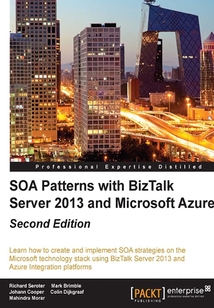首頁 > 計算機網(wǎng)絡(luò) >
編程語言與程序設(shè)計
> SOA Patterns with BizTalk Server 2013 and Microsoft Azure(Second Edition)最新章節(jié)目錄
目錄(133章)
倒序
- 封面
- 版權(quán)信息
- Credits
- About the Authors
- About the Reviewers
- www.PacktPub.com
- Preface
- Chapter 1. Building BizTalk Server 2013 Applications
- What is BizTalk Server?
- BizTalk architecture
- Setting up new BizTalk projects
- What are BizTalk schemas?
- What are BizTalk maps?
- Configuring BizTalk messaging
- Working with BizTalk orchestration
- Summary
- Chapter 2. Windows Communication Foundation Primer
- What is WCF?
- Defining the contract
- Implementing contracts in services
- Choosing an endpoint address
- The role of service bindings
- Hosting services
- Consuming WCF services
- Summary
- Chapter 3. Using WCF Services in BizTalk Server 2013
- The relationship between BizTalk and WCF
- Exposing WCF services from orchestrations
- Exposing WCF services from schemas
- Consuming WCF services from orchestrations
- Consuming WCF services without orchestration
- Summary
- Chapter 4. REST and JSON Support in BizTalk Server 2013
- Why REST services
- URL deciphering
- JSON versus XML
- Resource representation
- Handling message versioning in REST
- Documenting contracts
- Security
- BizTalk 2013 and REST
- Exploring the WCF-WebHttp Adapter
- Exposing a RESTful web service using BizTalk
- Pipeline to publish a typed message
- Receiving XML and JSON messages via the Post method
- Consuming a web service
- Sending a JSON message to a RESTful service
- Hiding the SVC filename extension
- Summary
- Chapter 5. Azure BizTalk Services
- What is MABS
- The MABS architecture
- Setting up new MABS projects
- MABS artifacts
- Configuring messaging in MABS
- Summary
- Chapter 6. Azure Service Bus
- Service Bus types
- Queue types
- Service Bus Queue characteristics
- Retrieving messages off a Queue
- Deferring message processing
- Security
- Topics
- Subscriptions
- Express Queues/Topics
- Partitioned Queues/Topics
- Event Hubs
- Relay Service
- Network transients
- Service Bus for Windows Server
- Administration tools
- Summary
- Chapter 7. Planning Service-oriented BizTalk Solutions
- The core principles of an SOA
- Identifying standard message exchange patterns
- Types of services
- Summary
- Chapter 8. Schema and Endpoint Patterns
- Service-oriented schema patterns
- Exploiting the reusable imported schema
- Service-oriented endpoint patterns
- Summary
- Chapter 9. Asynchronous Communication Patterns
- Why asynchronous communication matters
- Using asynchronous services in WCF
- Using asynchronous services in BizTalk with WCF
- Getting results from asynchronous invocations
- Using queues within asynchronous scenarios
- Summary
- Chapter 10. Orchestration Patterns
- Why orchestration?
- What is MessageBox direct binding?
- Using dynamic service ports
- Supporting dual initiating message exchange patterns
- Chaining orchestrations using business rules
- The role of transactions in aggregated services
- Building message-type agnostic orchestrations
- Summary
- Chapter 11. Versioning Patterns
- Why versioning?
- What service aspects may undergo changes?
- How to version schemas?
- How to version endpoints?
- Versioning long-running orchestrations
- Versioning other BizTalk components
- File versions
- Versioning BRE components
- Techniques for delaying change
- Summary
- Chapter 12. Frameworks and Tools
- ESB Toolkit
- BizUnit 4.0
- Monitoring tools
- The BRE Pipeline Framework
- BizTalk Documenter
- Sentinet
- Further reading
- Summary
- Chapter 13. New SOA Capabilities in BizTalk Server 2013 – Azure Hybrid Patterns
- Advantages of a hybrid solution
- Disadvantages of a hybrid solution
- SOA patterns used in hybrid solutions
- Special security considerations
- Monitoring assets on the ground and on the cloud
- Handling scalability availability and performance
- Summary
- Chapter 14. What's New and What's Next?
- BizTalk Server 2013 R2
- Azure App Services
- Azure API Management
- Summary
- Index 更新時間:2021-07-16 13:57:04
推薦閱讀
- Learning Single:page Web Application Development
- 數(shù)據(jù)庫原理及應(yīng)用(Access版)第3版
- Python程序設(shè)計(第3版)
- WSO2 Developer’s Guide
- 營銷數(shù)據(jù)科學:用R和Python進行預(yù)測分析的建模技術(shù)
- Groovy for Domain:specific Languages(Second Edition)
- Responsive Web Design by Example
- 超簡單:用Python讓Excel飛起來(實戰(zhàn)150例)
- C語言程序設(shè)計與應(yīng)用實驗指導(dǎo)書(第2版)
- Android智能手機APP界面設(shè)計實戰(zhàn)教程
- ArcPy and ArcGIS(Second Edition)
- 計算機系統(tǒng)解密:從理解計算機到編寫高效代碼
- jMonkeyEngine 3.0 Beginner’s Guide
- HTML5程序開發(fā)范例寶典
- Appcelerator Titanium Smartphone App Development Cookbook
- Spring MVC Blueprints
- C++ Windows Programming
- HTML5 Boilerplate Web Development
- Learning Behavior:driven Development with JavaScript
- Developing Multi:Platform Apps with Visual Studio Code
- Java并發(fā)編程實戰(zhàn)
- C/C++程序設(shè)計:計算思維的運用與訓(xùn)練
- 瘋狂Java講義(第5版)
- 中文版AutoCAD項目教程
- Getting Started with Zurb Foundation 4
- The Data Wrangling Workshop
- Visual C#.NET程序設(shè)計教程(第2版)
- Processing創(chuàng)意編程:生成設(shè)計|數(shù)據(jù)可視化|聲音可視化
- JavaScript and JSON Essentials
- PowerShell for SQL Server Essentials


